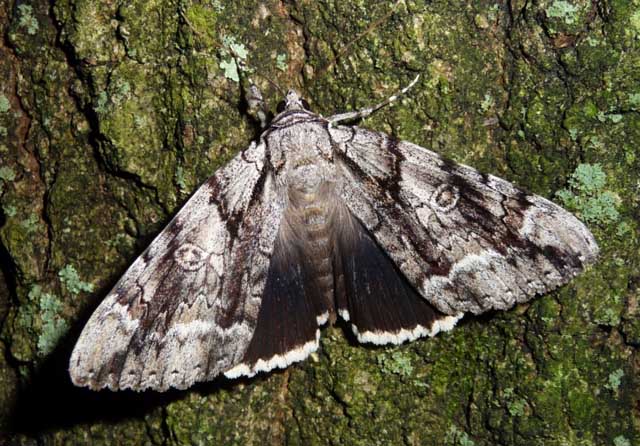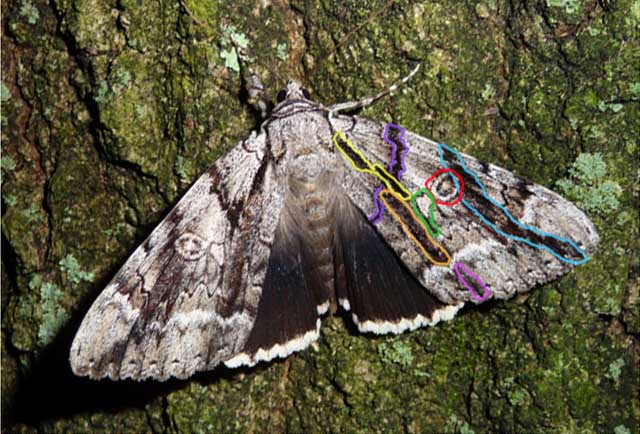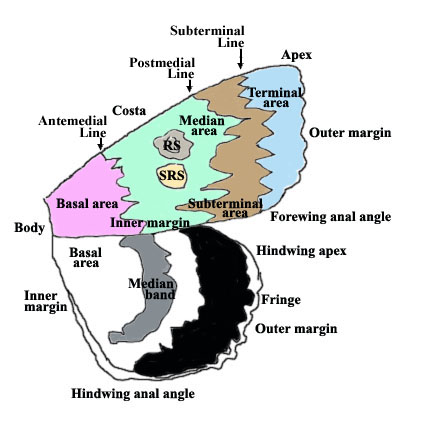
Catocala vidua, East Brunswick, Middlesex County, New Jersey,
September 21, 2011, courtesy of David Moskowitz.

Catocala vidua, East Brunswick, Middlesex County, New Jersey,
September 21, 2011, courtesy of David Moskowitz.
I have outlined various features in different coloured inks on David's image of C. vidua, and have entered some comments so that techniques I use for determinations might be of use to others.

Catocala vidua, East Brunswick, Middlesex County, New Jersey,
September 21, 2011, courtesy of David Moskowitz.
My second step was to apply a process of elimination. There are fifty-eight Catocala species listed for New Jersey, but only seventeen of them have black hindwings.
I took note (third step) of any prominent arcs, dashes, streaks and/or bars, and the characters of the reniform spot, subreniform spot, antemedian line and postmedian line. This specimen has a prominent dark arc (outlined in pale blue; third step A) running from costa, above reniform spot (outlined in red), to outer margin just below apex.
Applying that single feature to the checklist, I was able to eliminate all species with black underwings except for flebilis, retecta, luctuosa, angusi, vidua and maestosa.
I noted (third step B) prominent, thin, dark dashes (outlined in yellow) in the basal area, passing through the midpoint of the am line (outlined in purple) to just below the subreniform spot (outlined in green). This allowed me to eliminate maestosa (no dashes in basal area) and to eliminate flebilis and angusi whose basal dashes are much thicker and whose dark arc (third step A) does not run to the costa above the reniform spot.
I noted (third step C) diffuse bar (outlined in orange) in lower portion of median area, parallel to inner margin. Neither retecta nor luctuosa have such a bar.
Now I think there is strong possibility the specimen is vidua (by preliminary elimination) and check other noted features, not just on the checklist, but also on the individual species file, looking for additional support/comparisons (fourth step). I note the subreniform spot on David's specimen is quite constricted as it approaches the pm line. This is consistent with other images I have of vidua. In the additional images I have of retecta and luctuosa the subreniform spot is not nearly so constricted. I also note that the dark arc (step 3A) in retecta and luctuosa runs from the outer margin to the bottom of the reniform spot; in vidua the similar dark arc runs to the top of the reniform spot and then to costa.
I also note very heavy black on upper half of am line on David's image, consistent with vidua, and other features are consistent (fifth step): (pm line, terminal and subterminal areas) with vidua, and am comfortable going with that determination.
I am using quite a few terms that might not be in the readers' memory so here is an image that might help with some of the terminology.
 |
In my descriptions I refer to wing edges, areas, lines, spots, markings, etc. on the wings of these moths.
The upper edge of the forewing, running from the thorax (body) to the wing tip (apex) is called the costa. The wing edge running from the apex to the anal angle is called the outer margin. The wing edge running from the anal angle to the body is called the inner margin.
In the forewing, the pink region close to the body is the basal area. It is separated from the pale green median area by the antemedian line. This antemedian line may be thick or thin, distinct or indistinct, single or double. Its shape is usually consistent within a species.
Another line, the postmedian line, separates the pale green median area from the pale brown subterminal area. This postmedian line may be thick or thin, distinct or indistinct, single or double. Its shape is usually consistent within a species. I refer to the two upper most projections of this line, toward the outer margin, as teeth. In some species they are quite thin and elongate, giving them a very sharp appearance. In other species the upper teeth may be considerable shorter and blunter. Lower teeth are practically non-existent in some species, but quite prevalent in others.
A third line, often much less distinct, more diffuse, is called the subterminal line. It divides the pale brown subterminal area from the pale blue terminal area. Often there are dashes (thin dark lines), bars (thicker, longer lines), and/or dark arcs in any or many of these areas.
Almost all Catocala have two distinct spots in the forewing median (middle) area. The upper marking, closest to the costa, is called the reniform spot (RS). It may be large or small, single walled or double walled. The lower marking is called the subreniform spot (SRS). It may be large or small and may have a characteristic shape. I refer to this spot as being "open" when it is shaped like a pork chop with an elongated "handle" interrupting the post median line.
It has taken me quite a while to learn to focus on precise characters, and sometimes I have a note pad in front of me listing possibilites and then X-ing out the possiblities one by one when I see something is present on the specimen in question that is not apparent on possibilities written down, or vice-versa.
I can still remember as a boy, over fifty years ago, being very impressed by a gentleman named Joe Mueller who would often come to visit my father in New Jersey. Joe was an expert with Catocala and would "sugar bait" some of the trees in our area, and also enjoyed seeing what would come to our lights in the later summer and fall. He knew his Catocala very well, and had the determining characters memorized in his head. He could id the species almost immediately at first sight. He was also very proficient at determining gender by examining the frenulum.
When I receive images of spread specimens, it is also very useful to have wingspans (straight line distance from one forewing apex to the other forewing apex when the moths are spread so that the inner margin of each forewing is at a 90 degree angle to the body, or in one straight line). That measurement can be very helpful in the elimination process.
It is also useful for comparison purposes to have a series of images of similar species all on the same page. Checkout Identification Keys for black underwings.
Hindwings, when visible, also offer important clues. The colour of the fringes, the amount/degree of checking (interruption of fringes along wing veins), the shape of the apical patch are often invaluable. For the Catocala with yellow, orange, red, pink, etc., hindwings, the shape of the black median and marginal bands is often diagnostic. Some species have dark hairs in the basal area and along the hindwing inner margin, while others species are totally without the darker hairs.
I would describe the hindwing fringes on David's specimen of vidua as brilliant white with limited black checking along the veins.
Do not expect to become an expert overnight. Many species are very similar, and ids are further complicated when specimens are worn or faded.
There are some species that are so similar that if wingspan and a view of the hindwings are not available, then all I can do is narrow the id down to two or three possibilities.
I note that I still have some work to do with id keys for species with orange, and/or red hindwings.
Use your browser "Back" button to return to the previous page.